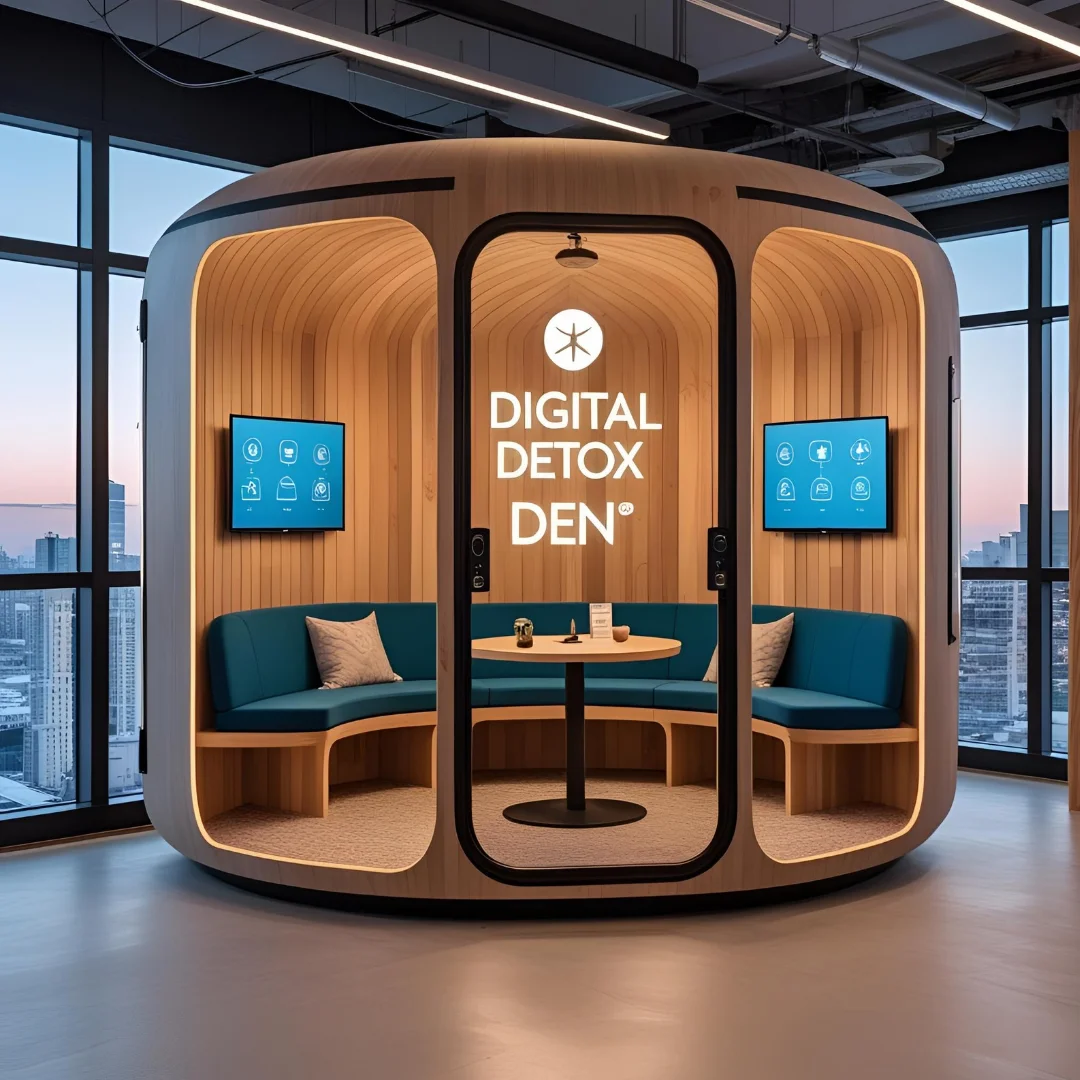Project Overview
The mental health issue I've chosen to address is Digital Burnout.
MindBloom Product: "Digital Detox Den"
The "Digital Detox Den" is a physical, smart-tech enabled pod designed to provide a dedicated, distraction-free space for individuals to
disconnect from their digital devices and engage in restorative activities. It's not just a quiet room; it's an immersive environment crafted to
gently guide users away from digital overload.
Key Features:
* Adaptive Lighting & Soundscapes: The Den features tunable LED lighting that mimics natural circadian rhythms and a sound system that plays
calming nature sounds, binaural beats for focus, or gentle white noise.
* Aromatherapy Diffusion: Integrated diffusers release therapeutic essential oils (e.g., lavender for relaxation, peppermint for clarity) to enhance
the sensory experience.
* Tactile Engagement Zone: A small, built-in drawer contains analogue activities like adult coloring books, simple puzzles, journaling supplies, or
stress balls, encouraging non-digital engagement.
* Device Charging Lockbox: Upon entering, users place their digital devices into a secure, opaque charging lockbox, preventing immediate
access and removing the temptation to check notifcations. The lockbox releases devices only after a pre-set "detox" duration.
* Guided Mindfulness Prompts: A discreet, non-screen interface offers optional audio prompts for short meditation exercises, breathing
techniques, or guided relaxation.* Biometric Feedback (Optional): For advanced users, an optional integration with wearable tech could provide post-detox insights into heart
rate variability, sleep quality, and stress levels, demonstrating the positive impact of the detox.
* Modular Design: Available in various sizes, from a personal "mini-den" for home use to larger corporate versions for ofce wellness rooms.
Explaining the Digital Detox Den:
For a 5-Year-Old (Simple and Playful Voice):
"Hey there, super-kid! Do you know how sometimes your eyes get tired from looking at too many bright screens, like your mommy or daddy's
phone, or the TV? It's like your brain needs a little nap from all those fashing lights!
Well, imagine a super cozy, secret hideout, just for you! It's called the Digital Detox Den! Inside, it's super soft and squishy, and you can listen to
gentle sounds like birds singing or a sleepy waterfall. There are no buzzing phones or silly games here. Instead, you can draw colorful pictures,
build with soft blocks, or just snuggle up and dream of your favorite toys. When you go in, your grown-up's phones get a special nap in a little
box, so they can't make any noise! When you come out, your eyes feel rested, and your brain is super fresh and ready for more fun! It's like giving
your brain a big, happy hug!"
For a 50-Year-Old CEO (Strategic and Market-Focused Voice):
"Good morning. I'm here to introduce a groundbreaking solution addressing a burgeoning corporate challenge: Digital Burnout. Our new
MindBloom product, the Digital Detox Den, is not merely a novelty; it's a strategic investment in employee well-being, productivity, and retention.The Den is a meticulously engineered, immersive physical space designed to facilitate genuine disconnection from the pervasive digital
environment. We recognize that constant connectivity, while enabling agility, also erodes cognitive bandwidth, increases stress, and
signifcantly contributes to burnout, impacting focus, creativity, and overall output.
The Digital Detox Den offers a curated, sensory-rich environment – utilizing adaptive lighting, soundscapes, and aromatherapy – to guide users
into a state of restorative calm. Its integrated device lockbox critically removes the immediate temptation of digital distraction, while the tactile
engagement zone encourages analog, mindful activities. Optional biometric integration provides measurable ROI on employee well-being
initiatives.
Consider the implications: reduced absenteeism, enhanced employee focus, improved decision-making, and a demonstrably more resilient
workforce. This is a proactive step towards cultivating a high-performance culture that prioritizes sustainable productivity over constant,
ultimately debilitating, connectivity. We're not just selling a product; we're offering a tangible solution to a critical facet of modern workplace
health, positioned to enhance your human capital and drive long-term organizational success. The initial market penetration will target
corporate wellness programs and high-stress professional environments, with scalable models for broader adoption."
Refection on Marketing Approach Adaptation:
Adapting the message for different audiences drastically changed the marketing approach.
For the 5-year-old, the approach was entirely focused on simplicity, relatability, and emotional appeal. I used highly visual language ("super cozy,
secret hideout," "super soft and squishy"), employed analogies they could understand ("brain needs a little nap," "giving your brain a big, happy
hug"), and emphasized direct, personal benefts ("eyes feel rested," "brain is super fresh"). The goal was to evoke curiosity, comfort, and the idea
of a fun, safe space. The "problem" (tired eyes) was presented in a non-threatening, easily graspable way.
For the 50-year-old CEO, the approach shifted dramatically to strategy, ROI, and problem-solving. The language became formal, professional,
and data-driven, even without explicit numbers in this initial pitch. I immediately framed "Digital Burnout" as a "burgeoning corporate challenge,"
positioning the Den as a "groundbreaking solution" and a "strategic investment." The focus was on tangible business benefts: "employee wellbeing, productivity, and retention," "reduced absenteeism," "enhanced employee focus," and "long-term organizational success." I used words like
"meticulously engineered," "curated," and "measurable ROI." The emotional appeal was replaced by a logical appeal to efciency, competitive
advantage, and human capital management. The CEO doesn't need to be entertained; they need to see how this product solves a problem and
adds value to their bottom line.
The core product remained the same, but the narrative, vocabulary, emphasis, and perceived value proposition were completely transformed to
resonate with the specifc needs, motivations, and understanding of each distinct audience. For the child, it's about comfort and play; for the
CEO, it's about strategic advantage and business outcomes.


This is a dummy comment to demonstrate the design. Real comments will be loaded dynamically.